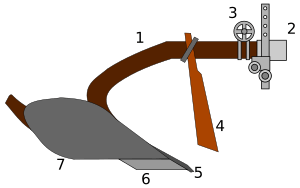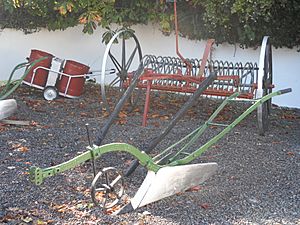Plough facts for kids
A plow (sometimes spelled plough) is a simple but very important machine used in farming. Farmers use plows to prepare the ground for planting. A plow is pulled across the field by a human or an animal, like a yak or a horse. When it moves, the plow lifts up the dirt, making it looser. This loose dirt is much better for seeds to grow in.
Parts of a Plow
Modern plows have several key parts that work together. Look at the diagram to see them:
- Beam: This is the main frame of the plow.
- Hitch: This part connects the plow to whatever is pulling it, like a tractor or an animal.
- Vertical regulator: This helps adjust how deep the plow goes into the soil.
- Coulter: This is a sharp blade that cuts the soil vertically. It can be a knife or a disk.
- Chisel: This is a small, sharp point that helps break into the soil first.
- Share: This is the main cutting part that slices through the soil horizontally.
- Mouldboard: This curved part lifts and turns over the soil after it's been cut.
Some parts of a plow, like the share and mouldboard, can wear out over time because they rub against the soil. Farmers can replace these parts without needing a whole new plow.
History of Plowing
Long ago, when farming first started, people used simple digging sticks or hoes to prepare the soil. This was especially true in places with naturally rich soil, like near the Nile River in Africa. The Nile River would flood every year, which made the soil fresh and ready for planting.
But in other areas where floods were rare, farmers needed a different way to make the soil good for crops. This is when plowing began. The first plows were probably just improved hoes. Over thousands of years, plows became more advanced. They changed from simple hand tools to tools pulled by animals, and much later, by powerful machines like tractors. Plowing helped people grow more food and was a big step forward in the history of farming.
Images for kids
-
13th century depiction of a ploughing peasant, Royal Library of Spain
-
Farmers using a plough. Akkadian Empire seal, circa 2200 BC. Louvre Museum
-
A British woman ploughing on a World War I recruitment poster for the Women's Land Army.
-
A modern John Deere 8110 Farm Tractor using a chisel plough. The ploughing tines are at the rear, the refuse-cutting coulters at the front.
-
Back side of a 100 mark banknote issued 1908
-
1975 Italian lira coin
-
Robert Burns statue, Schenley Park, Pittsburgh
-
The Gefion Fountain in Copenhagen
-
Ploughing in the Nivernais by Rosa Bonheur (1849)
See also
 In Spanish: Arado para niños
In Spanish: Arado para niños































